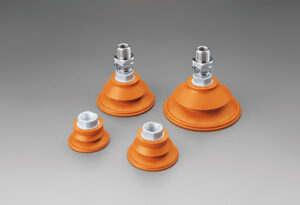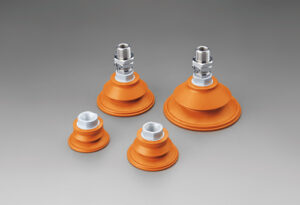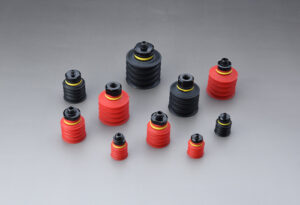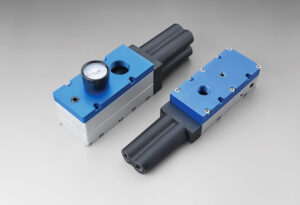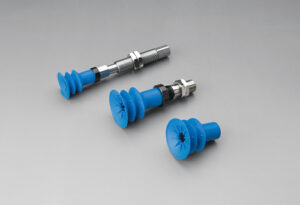Introduction
A reliable gripping mechanism is crucial in industrial applications that handle various objects. Vacuum suction cups play a significant role in achieving efficient and secure material handling. This article explores the science behind vacuum suction cups, addressing users’ queries seeking to purchase these devices. Understanding the underlying principles enables you to make informed decisions and optimize gripping performance for your application needs.
Understanding the Science Behind Vacuum Suction Cups
To comprehend the functioning of vacuum suction cups, let’s first establish a basic overview of their operations. A vacuum suction cup typically consists of several key components, each serving a specific purpose to ensure effective gripping performance.
The primary component is the suction cup, often made of flexible and durable materials such as silicone or rubber. This flexibility allows the suction cup to conform to various shapes and contours, providing a reliable seal against the lifted object. The sealing mechanism is another critical element, ensuring airtightness between the suction cup and the object’s surface.
Generating and maintaining the vacuum is essential for the suction cup’s functionality. Vacuum generation is typically achieved through a vacuum pump or a vacuum generator. The vacuum pump removes the air from the sealed space within the suction cup, creating a pressure difference that enables the mug to adhere to the object. Maintaining the vacuum level ensures a consistent gripping force over time.
Lastly, surface adaptability and contact area play significant roles in gripping performance. A larger contact area between the suction cup and the object distributes the gripping force more evenly, enhancing stability. Additionally, the adaptability of the suction cup to different surfaces, whether smooth, rough, or irregular, impacts its ability to form a secure seal.
Factors Affecting Gripping Performance
While understanding the basic components of vacuum suction cups is essential, it’s equally important to consider the factors influencing their gripping performance. Considering these factors, you can make informed decisions when selecting and utilizing vacuum suction cups for your specific application.
- Surface characteristics: The surface of the object being handled plays a crucial role in the adhesion capabilities of a vacuum suction cup. Smooth, non-porous surfaces are generally more suitable for achieving a reliable grip. However, rough or porous surfaces might present challenges and require specialized suction cups designed for such conditions.
- Load capacity: The load capacity refers to the maximum weight that a vacuum suction cup can handle. It’s vital to ensure that the chosen suction cup has a load capacity that meets or exceeds the importance of the objects you intend to grip. Choosing an undersized suction cup may result in reduced gripping force and instability.
- Environmental conditions: The surrounding environment can significantly impact the performance of vacuum suction cups. Temperature variations can affect the flexibility of the suction cup material, potentially compromising the seal. Likewise, changes in atmospheric pressure can influence the gripping force. Moisture or contaminants on the surface may also hinder the suction cup’s ability to form a reliable seal.
It is crucial to consider these factors during the selection process to optimise gripping performance and ensure compatibility between the suction cup and the specific application requirements.
Improving Gripping Performance
Now that we have a foundational understanding of the science behind vacuum suction cups and the factors that affect their gripping performance let’s explore strategies for enhancing their effectiveness.
- Selecting the right vacuum suction cup: Choosing the appropriate suction cup is paramount to achieving optimal gripping performance. Consider factors such as load capacity, surface compatibility, and environmental conditions. Consult with manufacturers or suppliers who can provide guidance based on your specific application needs.
- Optimizing suction cup placement and orientation: Proper order and direction of the suction cup can significantly impact gripping performance. Ensuring a secure seal and maximizing the contact area between the suction cup and the object is crucial. Experiment with different orientations and positions to find the most effective gripping configuration.
- Enhancing maintenance and care: Regular maintenance and care contribute to prolonged suction cup performance. Inspect the suction cups regularly for wear, damage, or debris accumulation. Clean the suction cup surfaces and ensure proper storage when not in use. These simple maintenance practices can help maintain the gripping performance and extend the lifespan of the suction cups.
Advanced Techniques and Innovations
In recent years, advancements in vacuum suction cup technology have introduced innovative techniques to improve gripping performance further. These developments address specific challenges and enhance functionality in various industrial applications. Here are a few notable advancements:
- Adaptive suction cups for irregular surfaces: Traditional suction cups may struggle to grip objects with uneven or rough surfaces. Adaptive suction cups incorporate advanced materials and design elements to conform to such feelings, allowing for a more secure grip. These specialized suction cups utilize flexible and deformable structures to adapt to the contours of the objects being handled.
- Intelligent sensors and feedback systems: Real-time monitoring of gripping performance can be achieved by integrating smart sensors and feedback systems. These systems provide valuable data on the gripping force, vacuum level, and seal integrity. Operators can adjust as needed by monitoring and analyzing this information, ensuring consistent and reliable gripping performance.
- Emerging technologies for improved suction cup design: Ongoing research and development in vacuum suction cups continue introducing new materials, methods, and manufacturing techniques. For instance, advancements in nanotechnology have led to the development of suction cups with specialized coatings that enhance adhesion on challenging surfaces. Additionally, using 3D printing technology allows for creating customized suction cup designs tailored to specific applications.
Conclusion
Understanding the science behind vacuum suction cups is essential for users looking to improve their gripping performance. By considering the key components, factors influencing gripping performance, and strategies for optimization, users can make informed decisions when selecting and utilizing vacuum suction cups for their specific needs. Additionally, staying updated with advanced techniques and emerging technologies can enhance gripping performance and provide innovative solutions to complex gripping challenges.
When purchasing vacuum suction cups, consult manufacturers or suppliers who can provide expert advice based on your application requirements. With the right knowledge and proper implementation, vacuum suction cups can significantly enhance the efficiency and reliability of material handling processes.
By leveraging the science behind vacuum suction cups and staying informed about the latest advancements, users can achieve improved gripping performance and optimize their industrial operations.



